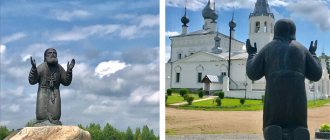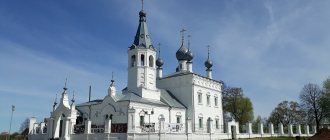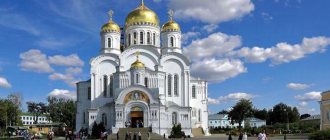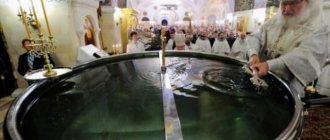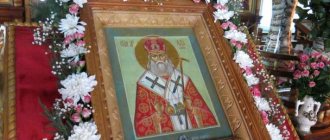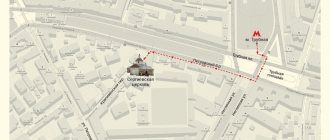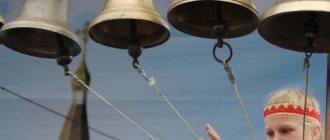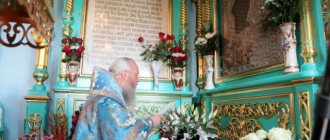In a quiet picturesque place, far from the bustle of the city, the temple in the name of St. John Chrysostom in the village of Godenovo rises among the fields and forests of the Yaroslavl land. Despite the significant solitude and remoteness of the temple from traffic intersections, the flow of pilgrims to this holy place does not dry out. People come to venerate the greatest Orthodox shrine - the Life-Giving Cross of the Lord.
History of the Appearance of the Cross
The story of the appearance of the Miraculous Cross on Russian soil is truly wonderful. The legend tells us that this shrine appeared from the “Greek side”, and this happened exactly 30 years (to the day!) before the capture of Constantinople, which marked the final fall of the Byzantine Empire - the stronghold of the Orthodox Church. On June 29, old style (11 new), 1423, in the Sahota swamp, shepherds saw a pillar of light coming from heaven to earth. They made their way to this place for a long time through impassable swampy places, and when they arrived, they saw a Miracle. In a pillar of light in the air stood the Life-Giving Cross, and next to it was the image of St. Nicholas with the Holy Gospel in his hands. And they heard a voice proclaiming that a “house of God” would be built on this place, and that everyone who came here would receive help and healing from the Cross of the Lord.
The builders who were entrusted with building the temple laid the foundation of the church a little away from the place of the appearance of the Cross, since the place was very swampy and unsuitable for construction. However, on the same night, the miraculously founded temple was moved to the place indicated by Nicholas the Wonderworker, where a hill convenient for construction was formed.
From the very time the built church was consecrated in the name of St. Nicholas with the limit of the Life-giving Cross, people began to come to the Holy Crucifixion, receiving healing from the shrine. At that time, a book was kept of miracles occurring at Christ's Crucifixion.
The further fate of this great Orthodox shrine is no less surprising. The fire that “licked” the Church of St. Nicholas the Wonderworker from the face of the earth did not at all affect the Life-Giving Cross itself. People experienced unspeakable joy when they unearthed a Crucifix untouched by fire from the ashes. The legend testifies that at the thanksgiving service in front of the Cross saved in the fire, many were granted healing from illnesses and other mercies of God.
The Miraculous Cross survived even during the years of atheism, when particularly zealous activists tried with all their might to destroy the holy Crucifixion. At first they wanted to take the shrine out of the temple to publicly burn it. But no matter what efforts they made, they could not move the light wooden Cross from its place. Then the saw came into use. But she, too, turned out to be powerless before the Life-Giving Cross. One furious atheist only managed to chop off a small piece of the little finger of the image of the Savior crucified on the Cross with an ax. This man’s fellow villagers later testified that he died 50 years later from blood poisoning, which began precisely with the finger that he damaged on the image of the crucified Christ.
When the Church of the Exaltation of the Cross, which housed the Crucifixion until Soviet times, was destroyed, the shrine was moved to the Church of St. John Chrysostom in Godenovo. Now the Chrysostom Church is a courtyard of the St. Nicholas Women's Monastery, located in Pereslavl-Zalessky. The Wonderworker Nicholas himself, who, according to God’s miraculous providence, presented himself precisely on the day of the Exaltation of the Honest and Life-Giving Cross of the Lord, and to this day zealously guards the greatest ancient shrine. In the same temple there is a miraculous icon of St. Nicholas of Myra.
The fate of the Goden Cross is amazing and full of inexplicable events and phenomena. Although they are inexplicable only for people far from faith. For those who believe in the Lord, the entire history of the Cross Not Made by Hands in Godenovo is irrefutable proof of the power and mercies of God bestowed upon us, the weak and weak.
GODENOVO – ANTUSHKOVO
Pereslavl St. Nicholas Convent and Metochion: Church of St. John Chrysostom in the village of Godenovo
The history of the monastery begins in 1350. It was a difficult and dark time for Rus'. The exhausting Mongol conquest was intensified by the plague epidemic and drove people to despair, there was a need for spiritual support. It was at this time that the Lord gave the Russian land many holy saints who incessantly prayed for peace, secluded in the monasteries they created. The founder of the St. Nicholas Monastery, then still a man's monastery, is Dmitry Prilutsky - an amazing saint, spiritual friend and disciple of St. Sergius of Radonezh, creator of the cenobitic charter.
The first church that appeared on the marshy lands chosen for the monastery received its name in honor of St. Nicholas the Wonderworker.
The fate of the monastery was not easy. Several times, like a phoenix, it rose from the ashes. Since the 16th century, the monastery has experienced its heyday.
The chronicle of the monastery did not reflect the time of troubles, but, as is known, the Western influence that broke through at that time greatly shook Orthodox Rus'. In 1609, the Polish-Lithuanian conquerors devastated the monastery. In 1613, Elder Dionysius came to the ruined monastery, who had a vision of St. Nicholas the Wonderworker, who ordered him to renew the monastery in his name.
In 1898, the Synod decided to rename the St. Nicholas Monastery into a women's monastery. Until 1903, the monastery was restored, built and decorated.
The difficult time of revolutions and godless years fell heavily on the abbess and nuns in 1917. As a result of the revolution, the cathedral church of St. Nicholas was blown up, many buildings were used as warehouses, dormitories and schools.
In modern times, with God's help, the monastery has been restored and restored. Many shrines were preserved. In 1997, the monastery received an allotment of arable land in the village of Godenovo. Together with the land, the Church of St. John Chrysostom came under the control of the monastery, which became the courtyard of the St. Nicholas Monastery. The temple houses a great shrine - the Unrevealed Godin Cross.
St. Nicholas Monastery is a unique monument of architecture and spiritual life, dating back more than seven centuries of history. Despite frequent devastation and losses, many miraculous shrines were preserved in the monastery and its courtyard. The famous crosses of the St. Nicholas Monastery enjoy the greatest national fame: the Korsun precious Cross with particles of relics, brought by Equal-to-the-Apostles Prince Vladimir from Byzantium in the 10th century, as well as the miraculous Unrevealed Life-Giving Cross, better known as the Goden Cross.
Crowds of pilgrims flock to the Goden Cross every day. Each miracle performed through prayers at the Cross is recorded in a special book kept in the Church of St. John Chrysostom. Every year, religious processions are held on the territory of the monastery and its courtyard with the removal of the miraculous Cross.
The finding of the cross was miraculous (Unmanifested). Tradition says that on June 29, 1943, some shepherds grazing their flocks near the Sakhota swamp were awarded a vision of a wondrous light emanating from the east. At first, the shepherds were scared, but still decided to go and see with their own eyes what was the source of such a beautiful light. Having reached the place of the glow, the shepherds fell to their knees, as they saw a real miracle: the Cross and Crucifix stood in the air, illuminated by a golden glow. Near the cross stood St. Nicholas the Wonderworker with the Gospel. He was looking at the shepherds when they heard a voice from above calling them to build a temple on this God-chosen place.
Antushkovo. Monastery of the Descent of the Cross on St. Nicholas Churchyard.
The village of Antushkovo was previously called Nikolsky Pogost, since it was there that the local shepherds saw the appearance of the Life-Giving Cross with St. Nicholas the Wonderworker standing in front of it. On the site of the Nikolsky churchyard before the appearance of the Cross of the Lord there was a large swamp called Sakhotsky, which after the appearance of the Cross miraculously dried up overnight, forming a place for the construction of a church. In memory of the miraculous phenomenon, the newly built church was consecrated in honor of St. Nicholas the Wonderworker with a chapel in honor of the origin of the venerable tree of the Life-giving Cross of the Lord.
In 1776, on the site of a dilapidated wooden one, a stone church with three altars was built and consecrated: the main one - in honor of the Exaltation of the Precious and Life-Giving Cross of the Lord and the side chapels - in the name of St. Nicholas and in honor of the Intercession of the Mother of God. In 1824, at the Nikolsky churchyard, it was decided to build a monastery around the temple so that services at the shrine - the Life-giving Cross of the Lord - would be performed daily.
We managed to build a small brick factory and a cell building especially for this purpose. However, this is where it all ended for an unknown reason. The cell building was later given over to the Zemstvo Public School. At the beginning of the 19th century, the parish of the St. Nicholas Church was quite large: thirteen villages with a population of about 1,500 people.
The Church of the Exaltation of the Cross on St. Nicholas Church operated until 1927, when it was completely plundered, and its rector, Father John Dobrotin, was arrested and exiled to a camp, where he died in 1931. The proletarian “Red Commune” is formed at the Nikolsky churchyard, the cell building becomes a hostel for Ivanovo workers. At this time, it was decided among the parishioners to move the Shrine away from the communards mocking it to the closest church of St. John Chrysostom in the village of Godenovo, which operated until 1929, then was closed, but not looted, and stood abandoned in the middle of the village. No one can say the exact date of the transfer of the Cross. The most likely date is 1933. According to the stories of local residents, it was in this year that all participants in this religious procession were dispossessed and deported. And they carried the Cross at night “with the whole collective farm.” The Cross stood in the abandoned Goden Church throughout the war. The Cross suffered a lot during this time from the new government - they burned it, sawed it, poured acid on it, and chopped it with an ax. But the Cross never succumbed to the tormentors; only minor damage and scratches remained for the edification of posterity.
The Nikolsky churchyard was completely ruined during the godless years. After the communards' hostel, there was an orphanage there, but in the 50s there was a strong fire: many village houses and a barnyard burned down, the fraternal building burned out inside, but the church remained intact. In the 60s, a machine and tractor station was organized near the deserted Nikolsky churchyard, but for some reason it did not work, and the holy place was completely deserted. So the Nikolsky churchyard, after five hundred years of glorious history, again turned into the Sakhota swamp. But not for long. In the mid-1990s, on the site of the appearance of the Life-Giving Cross, a monastery was founded in the name of the Descent of the Cross of the Lord. In 2004, the Holy Cross Church was almost completely restored, and a small wooden St. Nicholas Church was built.
Miracles of healing at the Life-Giving Cross in Godenovo
From the moment when the Church of St. John Chrysostom was transferred to the St. Nicholas Monastery, the sisters have carefully chronicled the miracles occurring at the Life-Giving Cross. Unfortunately, the fire that destroyed the St. Nicholas Church in the swamp did not leave us with a book in which the healings of past times were recorded. However, through the efforts of many people, some of this evidence was collected again and recorded. It is worth turning to these records and you are convinced that the Lord’s help is nearby - all we need is faith.
Photo from sudogda.ru
People from all parts of the world come to the Goden Cross, coming to venerate the shrine with various problems. Someone asks for help for children, someone turns to the Lord with hope to return peace to the family, someone asks for the gift of children. People come to worship the shrine in sorrows and illnesses, and according to our faith, the Lord grants miracles.
Healings occur from various ailments - burns, limb injuries, spinal diseases, diseases of internal organs (liver, kidneys, lungs, heart), oncology, severe mental illnesses, etc. The list goes on and on. Let us present a small piece of evidence recorded by the nuns of the St. Nicholas Monastery.
Irina from Mytishchi writes about her husband’s brother, who was diagnosed with tuberculosis. The diagnosis was confirmed by a highly qualified specialist, and the patient was hospitalized in a tuberculosis clinic. Irina and her husband, worried about their relative, went to Godenovo. A few days after fervent prayer for the sick man at the Cross, the diagnosis was changed to pneumonia. The patient recovered quickly.
Alexander from Moscow was healed of severe colic, the cause of which none of the doctors could establish. They ordered a prayer service at the Chrysostom Church, after which they defended and went home. Upon arrival, after a severe attack of colic, Alexander passed a large stone, which was not detected during examinations. Since then the pain has not returned.
With holy water, consecrated at a prayer service to the Miraculous Cross, 30-year-old Muscovite Anna Minaeva received relief from a chronic form of pyelonephritis.
After visiting Godenovo, another Muscovite, Vera Vasilievna Orlova, was miraculously healed of hepatitis of unknown origin.
Many records tell of miraculous healings from the consequences of injuries. For example, Tatyana Ivanovna Sotnikova from Ivanovo, after she venerated the Cross, a severely painful injured toe went away.
Trauma during the war in Afghanistan immobilized one young man. One day he dreamed of Nicholas the Wonderworker, calling him to venerate the Life-Giving Cross. Having persuaded his relatives to take him to Godenovo, the young man venerated the shrine, took communion in the church and ordered a prayer service. The healing took place in front of the parishioners - for the first time he got out of his wheelchair on his own.
Muscovite Margarita received a severe traumatic brain injury after being hit by a car. The consequences were so serious that she was left disabled. Her family turned away from her. With great difficulty she reached the temple in Godenovo, where St. Nicholas appeared to her. Witnesses say that visible signs of healing occurred immediately - the gait became confident and fast, the right hand began to move, and speech was almost completely restored.
Photo from orthpoto.net
Cases of healing from skin diseases are also recorded: Ksenia from the Kherson region was cured of psoriasis, and the little daughter of the Ignatiev family from Moscow was cured of severe eczema, which doctors could not cure.
The Life-Giving Cross often provides relief from mental disorders and demonic possession. Parishioners often witness that some visitors cannot approach the Cross and begin to scream, bark or crow.
Among the pilgrim group from Bryansk, the sick Natalia, who had not spoken since she was three years old, took part in the prayer service at Christ’s Crucifixion. Pilgrims say that on her way back, Natalia suddenly began to utter her first words.
Pereslavl doctor Igor told how, at his insistent request, he brought the disabled Alexander, who suffered from mental illness, to the Cross. When asked why he does not wear a pectoral cross, Alexander replied that it was too heavy. After he venerated the Holy Miraculous Crucifix, the patient said that he could now put on a cross. Now Alexander often asks to go to Godenovo. His condition has improved significantly, and hallucinations have become less frequent.
Over the centuries-old history, a lot of different evidence of healing has been collected, and every year they are added.
- Description
- Pilgrimages (4)
- Trips here (22)
Description of the Monastery of the Descent of the Cross in the village. Antushkovo
The monastery is located near the village of Antushkovo on the border of the Yaroslavl and Ivanovo regions.
It is located on a high hill with steep slopes, above a wide river valley. Jordanian.
Among the surviving buildings, the one erected in the middle stands out from afar. 19th century high bell tower. The five-domed Church of the Exaltation of the Cross itself, built in 1776 at the expense of parishioners, was dismantled in 1974; Only its northern aisle has survived. 19th century To the east stretches a long two-story almshouse building - it was built in the middle. 19th century like a cell body. The buildings were surrounded by a stone fence, from which, to the west of the almshouse, only the chapel that was part of the fence survived (mid-19th century). The walls of all buildings are brick and plastered. Several old linden trees have been preserved on the territory of the churchyard.
The bell tower of the Church of the Exaltation of the Cross has been preserved to the height of two tiers; only a fragment remains from the third. Part of the northern aisle, which was added to the temple at the same time as the bell tower, also survived. Despite its poor state of preservation, it is an expressive monument in the style of mature classicism.
How to get there:
From the village Petrovskoye (M8 passes through it) to the right.
After the village of Priozerny there will be a left turn towards Godenovo, before reaching Zakharovo. If you drive further, past Zakharovo, the road (an embankment dam) will lead to Antushkovo (Nikolsky Pogost).
From the history:
The village of Antushkovo was formerly called Nikolsky Pogost, since it was there on May 29, 1423 that local shepherds saw the appearance of the Life-Giving Cross with St. Nicholas the Wonderworker standing in front of it. On the site of the Nikolsky churchyard before the appearance of the Cross of the Lord there was a large swamp called Sakhotsky, which after the appearance of the Cross dried up overnight, forming a place for the construction of a church. In memory of the miraculous phenomenon, the built church was consecrated in honor of St. Nicholas the Wonderworker with a chapel in honor of the origin of the venerable tree of the Life-giving Cross of the Lord. It was made of wood and burned down, but the same year it was rebuilt in wood. In 1776, on the site of a dilapidated wooden one, a stone church with three altars was built and consecrated: the main one - in honor of the Exaltation of the Precious and Life-Giving Cross of the Lord and the side chapels - in the name of St. Nicholas and in honor of the Intercession of the Mother of God.
In 1824, on the St. Nicholas churchyard, it was decided to build a monastery around the temple so that services at the Life-giving Cross of the Lord would be performed daily, which was previously impossible due to the small number of the parish Church of the Exaltation of the Cross. We managed to build a small brick factory and a cell building especially for this purpose. However, this is where it all ended for an unknown reason. The cell building was later given over to the Zemstvo Public School. At the beginning of the 19th century, the parish of the St. Nicholas Church was quite large: thirteen villages with a population of about 1,500 people.
The Church of the Exaltation of the Cross in the Nikolsky Pogost operated until 1927, when it was completely plundered, and its rector, Father John Dobrotin, was arrested and exiled to a camp near the village of Derevyansk in Komi, where he died on November 25, 1931. The proletarian “Red Commune” is formed at the Nikolsky churchyard, the cell building becomes a hostel for the communards - Ivanovo workers. At this time, it was decided among the parishioners to move the Shrine away from the communards mocking it to the closest church of St. John Chrysostom in the village of Godenovo, which operated until 1929, then was closed, but not looted, and stood abandoned in the middle of the village. No one can say the exact date of the transfer of the Cross. The most likely date is 1933. According to the stories of local residents, it was in this year that all participants in this religious procession were dispossessed and deported. And they carried the Cross at night “by the entire collective farm,” led by chairman Vasily Fomin. The Cross stood in the abandoned Goden Church throughout the war. The Cross suffered a lot during this time from the new government - they burned it and sawed it and poured acid on it and chopped it with an ax. But the Cross never succumbed to the tormentors; only minor damage remained as a warning to posterity.
The cross is still located in Godenovo.
Nikolsky Pogost was completely destroyed during the Soviet years. After the Communards' hostel, there was an orphanage there, but in the 50s there was a strong fire: many village houses burned down, but the church remained intact. In the 60s, a machine and tractor station was organized near the deserted Nikolsky churchyard. For its construction, bricks were taken by dismantling the vaults and walls of the Holy Cross Church. For some reason, MTS did not work and the holy place was completely deserted. So the Nikolsky churchyard, after five hundred years of glorious history, again turned almost into the Sakhota swamp.
In the mid-1990s, through the efforts of abbot Boris Khramtsov, a monastery was founded at the site of the apparition of the Life-Giving Cross in the name of the Descent of the Cross of the Lord. In 2004, the Holy Cross Church was almost completely restored, and a small wooden St. Nicholas Church was built.
Source: https://www.myrusland.ru/places_57.htm
Pilgrimage trips to the Monastery of the Descent of the Cross in the village. Antushkovo
- A trip from Mogilev to the Monastery of the Descent of the Cross in the village. Antushkovo
- A trip from Bobruisk to the Monastery of the Descent of the Cross in the village. Antushkovo
- A trip from Minsk to the Monastery of the Descent of the Cross in the village. Antushkovo
- A trip from Gomel to the Monastery of the Descent of the Cross in the village. Antushkovo
- A trip from Moscow to the Monastery of the Descent of the Cross in the village. Antushkovo
- A trip from Moscow to the Monastery of the Descent of the Cross in the village. Antushkovo
- A trip from Losino-Petrovsky to the Monastery of the Descent of the Cross in the village. Antushkovo
- A trip from Astrakhan to the Monastery of the Descent of the Cross in the village. Antushkovo
- A trip from Moscow to the Monastery of the Descent of the Cross in the village. Antushkovo
- A trip from Tver to the Monastery of the Descent of the Cross in the village. Antushkovo
- A trip from Kurovskoye to the Monastery of the Descent of the Cross in the village. Antushkovo
- A trip from St. Petersburg to the Monastery of the Descent of the Cross in the village. Antushkovo
- A trip from Fryanovo (Moscow region) to the Monastery of the Descent of the Cross in the village. Antushkovo
- A trip from Tver to the Monastery of the Descent of the Cross in the village. Antushkovo
- A trip from Moscow to the Monastery of the Descent of the Cross in the village. Antushkovo
- A trip from Tver to the Monastery of the Descent of the Cross in the village. Antushkovo
- A trip from Kolomna to the Monastery of the Descent of the Cross in the village. Antushkovo
- A trip from Moscow to the Monastery of the Descent of the Cross in the village. Antushkovo
- A trip from Yaroslavl to the Monastery of the Descent of the Cross in the village. Antushkovo
- A trip from Bear Lakes (Moscow region) to the Monastery of the Descent of the Cross in the village. Antushkovo
- A trip from Klin to the Monastery of the Descent of the Cross in the village. Antushkovo
- A trip from Fryazino to the Monastery of the Descent of the Cross in the village. Antushkovo
- A trip from Klin to the Monastery of the Descent of the Cross in the village. Antushkovo
- A trip from Zaraysk to the Monastery of the Descent of the Cross in the village. Antushkovo
- A trip from Moscow to the Monastery of the Descent of the Cross in the village. Antushkovo
- A trip from Yaroslavl to the Monastery of the Descent of the Cross in the village. Antushkovo
- A trip from Moscow to the Monastery of the Descent of the Cross in the village. Antushkovo
- A trip from Dushonov (Moscow region) to the Monastery of the Descent of the Cross in the village. Antushkovo
- A trip from Tver to the Monastery of the Descent of the Cross in the village. Antushkovo
- A trip from Likino-Dulyovo to the Monastery of the Descent of the Cross in the village. Antushkovo
- A trip from Voronezh to the Monastery of the Descent of the Cross in the village. Antushkovo
- A trip from Shchelkovo to the Monastery of the Descent of the Cross in the village. Antushkovo
- A trip from Klin to the Monastery of the Descent of the Cross in the village. Antushkovo
- A trip from Orekhovo-Zuevo to the Monastery of the Descent of the Cross in the village. Antushkovo
- A trip from Moscow to the Monastery of the Descent of the Cross in the village. Antushkovo
- A trip from Moscow to the Monastery of the Descent of the Cross in the village. Antushkovo
How to get to the Life-Giving Cross in Godenovo
It is very difficult to get to the Church of St. John Chrysostom by public transport. Therefore, it is better to go by car or with a pilgrimage service. However, if there are no such opportunities, then an intercity bus runs from Moscow from Shchelkovskaya metro station towards Yaroslavl. You need to get off at Petrovsk station. Next, you need to take a local regular bus, which runs 2-3 times a day, and ride it to the stop “village. Godenovo".
If you travel by car from Moscow, then travel 160 km along the Yaroslavskoye Highway from the Moscow Ring Road to the city of Petrovsk. Next you need to follow the signs “The Life-Giving Cross of the Lord, p. Godenovo". From Petrovsk the distance will be about 16 km.
The temple is open to the public every day from 8.00 to 20.00, but one can venerate the open feet of the Life-giving Cross of the Lord only on Fridays, Saturdays and Sundays.
Services in the temple are performed daily, except Mondays and Tuesdays. At 9.00 – Divine Liturgy, and at 17.00 – Vespers.
No matter how difficult the path to the Chrysostom Church is, this journey is worth making. The gracious power of the Holy Crucifixion of Christ acts in an indescribable way on those who are honored to visit this place. Having venerated the Cross, many do not want to leave, they strive to fall again to the shrine, experiencing such grace that cannot be described in words.
